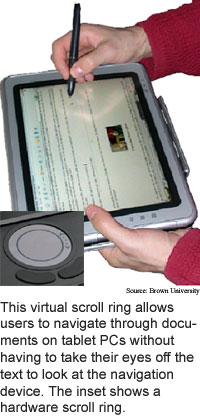
Virtual ring eases scrolling
Researchers from Brown University are aiming
to improve the scroll bar.
Although scrolling through documents is extremely common, the
most widespread technique for scrolling has a serious drawback: it takes
your attention away from the document you are working on, interrupting
your work.
Using the mouse wheel to scroll eliminates that drawback, but doesn't
work well for situations that involve large touchscreens or tablet PCs.
The Brown researchers have designed a software simulation of the
physical scroll ring that works like the mouse wheel but does not require
the hardware.
The virtual scroll ring maps circular finger, stylus, or mouse
motion into vertical scrolling. Clockwise motion moves the scroll bar
down and counterclockwise motion moves it up. Bigger circles and faster
motion increase scrolling speed.
Previous Interface techniques have allowed users to rotate objects
with circular motion but these are based on the angle of the pointer relative
to the center of the circle, which requires a fixed point on the screen.
The virtual scrolling is based on distance traveled around the circle,
meaning the circle can drift around the screen. This allows the user to
keep visual attention on the document.
The software is well-suited for pen-based computers and interactive
displays, which have limited screen and peripherals space, and which people
are likely to use increasingly over the coming decade, according to the
researchers.
In general, the software is an eyes-free technique for specifying
values. Scrolling distance is one value. The software can enable any application
with user-controlled parameters represented by slider bars or dials to
be used without having to look at the control, according to the researchers.
The technique can be implemented in any software now, according
to the researchers. They presented the research at the User Interface
Software and Technology (UIST) 2004 conference held in Santa Fe, New Mexico
October 24 to 27, 2004.
Light clock promises finer time
Physics model predicts book sales
Silicon ring boosts light chips
Molecule harvests water's hydrogen
Briefs:
Virtual ring eases scrolling
DNA makes nanotube transistors
Scheme simplifies quantum chips
Aligned nanotubes accommodate bone
Light writes info into atoms
See-through circuits speed up

Research Watch blog
View from the High Ground Q&A
How It Works
RSS Feeds:
News
Ad links:
Buy an ad link
Ad links: Clear History
Buy an ad link
|
TRN
Newswire and Headline Feeds for Web sites
|
© Copyright Technology Research News, LLC 2000-2010. All rights reserved.